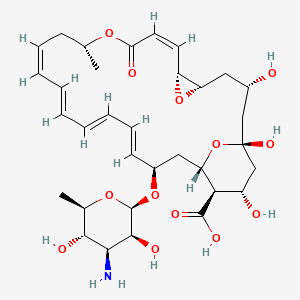



1. Myprozine
2. Pimafucin
3. Pimaricin
4. Tennecetin
1. Pimaricin
2. Tennecetin
3. Delvocid
4. Mycophyt
5. Myprozine
6. Synogil
7. 7681-93-8
8. Pimafucin
9. Natacyn
10. Pimaracin
11. Antibiotic A-5283
12. Cl 12,625
13. Pimaricine
14. Delvolan
15. Delvopos
16. Natafucin
17. 8o0c852cpo
18. Ins No.235
19. Ins-235
20. Nsc-759167
21. Cl-12625
22. Ene-25-carboxylic Acid
23. E-235
24. Cl 12625
25. Natamicina
26. Natamycine
27. Natamycinum
28. Pimarizin
29. 6,11,28-trioxatricyclo[22.3.1.05,7]octacosa-8,14,16,18,20-pentaene-25-carboxylic Acid, 22-[(3-amino-3,6-dideoxy-.beta.-d-mannopyranosyl)oxy]-1,3,26-trihydroxy-12-methyl-10-oxo-, (1r,3s,5r,7r,8e,12r,14e,16e,18e,20e,22r,24s,25r,26s)-
30. Pimarizin [german]
31. Natamycin(pimaricin)
32. Natamycine [inn-french]
33. Natamycinum [inn-latin]
34. Natamicina [inn-spanish]
35. Unii-8o0c852cpo
36. Natamycin [usan:usp:inn:ban]
37. Ncgc00016686-01
38. (1r,3s,5r,7r,8e,12r,14e,16e,18e,20e,22r,24s,25r,26s)-22-[(3-amino-3,6-dideoxy-?-d-mannopyranosyl)oxy]-1,3,26-trihydroxy-12-methyl-10-oxo-6,11,28-trioxatricyclo[22.3.1.05,7]octacosa-8,14,16,18,20-penta
39. (1r,3s,5r,7r,8e,12r,14e,16e,18e,20e,22r,24s,25r,26s)-22-[(3-amino-3,6-dideoxy-beta-d-mannopyranosyl)oxy]-1,3,26-trihydroxy-12-methyl-10-oxo-6,11,28-trioxatricyclo[22.3.1.0~5,7~]octacosa-8,14,16,18,20-pentaene-25-carboxylic Acid
40. 6,11,28-trioxatricyclo(22.3.1.05,7)octacosa-8,14,16,18,20-pentaene-25-carboxylic Acid, 22-((3-amino-3,6-dideoxy-.beta.-d-mannopyranosyl)oxy)-1,3,26-trihydroxy-12-methyl-10-oxo-, (1r,3s,5r,7r,8e,12r,14e,16e,18e,20e,22r,24s,25r,26s)-
41. E235
42. Cas-7681-93-8
43. Einecs 231-683-5
44. Mfcd00135085
45. Pimaricin; Natamycin
46. Natamycin [fcc]
47. Natamycin [inn]
48. Pimaricin [jan]
49. Natamycin [mi]
50. Natamycin [inci]
51. Natamycin [usan]
52. Natamycin [vandf]
53. Dsstox_cid_1163
54. Natamycin [mart.]
55. Natamycin [usp-rs]
56. Natamycin [who-dd]
57. Dsstox_rid_75985
58. Dsstox_gsid_21163
59. Schembl18140
60. Natamycin [orange Book]
61. Chembl1200656
62. Natamycin [usp Monograph]
63. Pimaricin 100 Microg/ml In Water
64. Ex-a1989
65. Hy-b0133
66. Zinc8220909
67. Tox21_110561
68. Bdbm50370755
69. Akos030485970
70. Cs-1909
71. Db00826
72. Nsc 759167
73. Nicotinamide_adenine_dinucleotide
74. 16-(3-amino-3,6-didesoxy-beta-d-mannopyranosyloxy)-5,6-epoxy-8,12,14-trihydroxy-26-methyl-2,10-dioxo-1-oxacyclohexacosa-3,17,19,21,23-pentaen-13-carbonsaeure
75. Stereoisomer Of 22-((3-amino-3,6-dideoxy-beta-d-mannopyranosyl)oxy)-1,3,26-trihydroxy-12-methyl-10-oxo-6,11,28-trioxatricyclo(22.3.1.0(sup 5,7))octacosa-8,14,16,18,20-pentaene-25-carboxylic Acid
76. Natamycin, Vetranal(tm), Analytical Standard
77. Ncgc00373238-02_c33h47no13_delvocid
78. 681n938
79. Pimaricin Preparation, ~2.5%, Aqueous Suspension
80. Q248466
81. Natamycin, United States Pharmacopeia (usp) Reference Standard
82. Pimaricin, From Streptomyces Chattanoogensis, >=95% (hplc)
83. Natamycin, Pharmaceutical Secondary Standard; Certified Reference Material
84. (1r,3s,5r,7r,8e,12r,14e,16e,18e,20e,22r,24s,25r,26s)-22-[(2r,3s,4s,5s,6r)-4-amino-3,5-dihydroxy-6-methyloxan-2-yl]oxy-1,3,26-trihydroxy-12-methyl-10-oxo-6,11,28-trioxatricyclo[22.3.1.05,7]octacosa-8,14,16,18,20-pentaene-25-carboxylic Acid
| Molecular Weight | 665.7 g/mol |
|---|---|
| Molecular Formula | C33H47NO13 |
| XLogP3 | -1.3 |
| Hydrogen Bond Donor Count | 7 |
| Hydrogen Bond Acceptor Count | 14 |
| Rotatable Bond Count | 3 |
| Exact Mass | 665.30474055 g/mol |
| Monoisotopic Mass | 665.30474055 g/mol |
| Topological Polar Surface Area | 231 Ų |
| Heavy Atom Count | 47 |
| Formal Charge | 0 |
| Complexity | 1220 |
| Isotope Atom Count | 0 |
| Defined Atom Stereocenter Count | 14 |
| Undefined Atom Stereocenter Count | 0 |
| Defined Bond Stereocenter Count | 5 |
| Undefined Bond Stereocenter Count | 0 |
| Covalently Bonded Unit Count | 1 |
| 1 of 2 | |
|---|---|
| Drug Name | Natacyn |
| PubMed Health | Natamycin (Into the eye) |
| Drug Classes | Antifungal |
| Drug Label | NATACYN (natamycin ophthalmic suspension) 5% is a sterile, antifungal drug for topical ophthalmic administration. Each mL of the suspension contains: Active: natamycin 5% (50mg). Preservative: benzalkonium chloride 0.02%. Inactive: sodium hydroxi... |
| Active Ingredient | Natamycin |
| Dosage Form | Suspension |
| Route | Ophthalmic |
| Strength | 5% |
| Market Status | Prescription |
| Company | Alcon |
| 2 of 2 | |
|---|---|
| Drug Name | Natacyn |
| PubMed Health | Natamycin (Into the eye) |
| Drug Classes | Antifungal |
| Drug Label | NATACYN (natamycin ophthalmic suspension) 5% is a sterile, antifungal drug for topical ophthalmic administration. Each mL of the suspension contains: Active: natamycin 5% (50mg). Preservative: benzalkonium chloride 0.02%. Inactive: sodium hydroxi... |
| Active Ingredient | Natamycin |
| Dosage Form | Suspension |
| Route | Ophthalmic |
| Strength | 5% |
| Market Status | Prescription |
| Company | Alcon |
For the treatment of fungal blepharitis, conjunctivitis, and keratitis caused by susceptible organisms including Fusarium solani keratitis.
Natamycin is an antifungal drug for topical ophthalmic administration. It is a tetraene polyene antibiotic derived from Streptomyces natalensis. It possesses in vitro activity against a variety of yeast and filamentous fungi, including Candida, Aspergillus, Cephalosporium, Fusarium and Penicillium. Although the activity against fungi is dose-related, natamycin is predominantly fungicidal. Natamycin is not effective in vitro against gram-positive or gram-negative bacteria. Topical administration appears to produce effective concentrations of natamycin within the corneal stroma but not in intraocular fluid.
Anti-Bacterial Agents
Substances that inhibit the growth or reproduction of BACTERIA. (See all compounds classified as Anti-Bacterial Agents.)
Anti-Infective Agents, Local
Substances used on humans and other animals that destroy harmful microorganisms or inhibit their activity. They are distinguished from DISINFECTANTS, which are used on inanimate objects. (See all compounds classified as Anti-Infective Agents, Local.)
Antifungal Agents
Substances that destroy fungi by suppressing their ability to grow or reproduce. They differ from FUNGICIDES, INDUSTRIAL because they defend against fungi present in human or animal tissues. (See all compounds classified as Antifungal Agents.)
A - Alimentary tract and metabolism
A01 - Stomatological preparations
A01A - Stomatological preparations
A01AB - Antiinfectives and antiseptics for local oral treatment
A01AB10 - Natamycin
A - Alimentary tract and metabolism
A07 - Antidiarrheals, intestinal antiinflammatory/antiinfective agents
A07A - Intestinal antiinfectives
A07AA - Antibiotics
A07AA03 - Natamycin
D - Dermatologicals
D01 - Antifungals for dermatological use
D01A - Antifungals for topical use
D01AA - Antibiotics
D01AA02 - Natamycin
G - Genito urinary system and sex hormones
G01 - Gynecological antiinfectives and antiseptics
G01A - Antiinfectives and antiseptics, excl. combinations with corticosteroids
G01AA - Antibiotics
G01AA02 - Natamycin
S - Sensory organs
S01 - Ophthalmologicals
S01A - Antiinfectives
S01AA - Antibiotics
S01AA10 - Natamycin
Absorption
Systemic absorption should not be expected following topical administration, and as with other polyene antibiotics, absorption from the gastrointestinal tract is very poor.
Like other polyene antibiotics, Natamycin inhibits fungal growth by binding to sterols. Specifically, Natamycin binds to ergosterol in the plasma membrane, preventing ergosterol-dependent fusion of vacuoles, as well as membrane fusion and fission. This differs from the mechanism of most other polyene antibiotics, which tend to work by altering fungal membrane permeability instead.